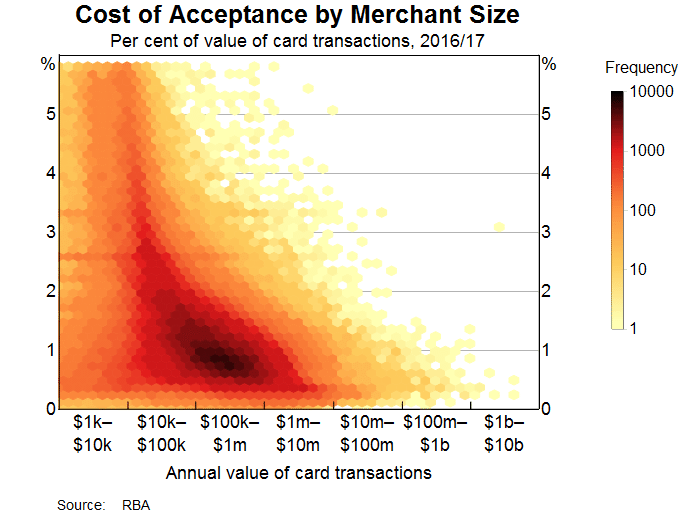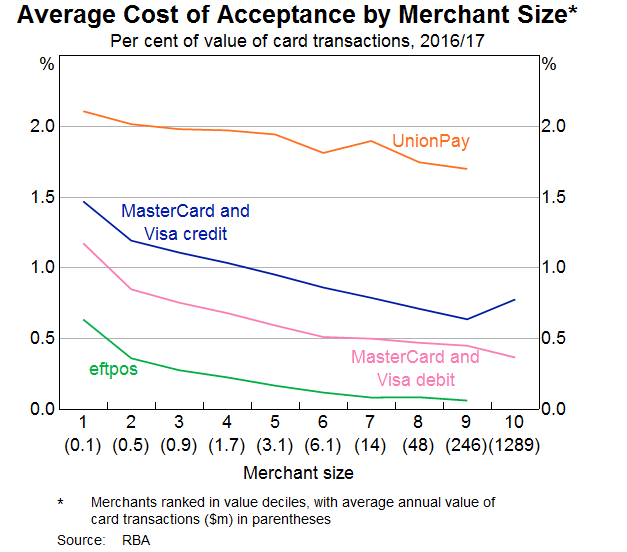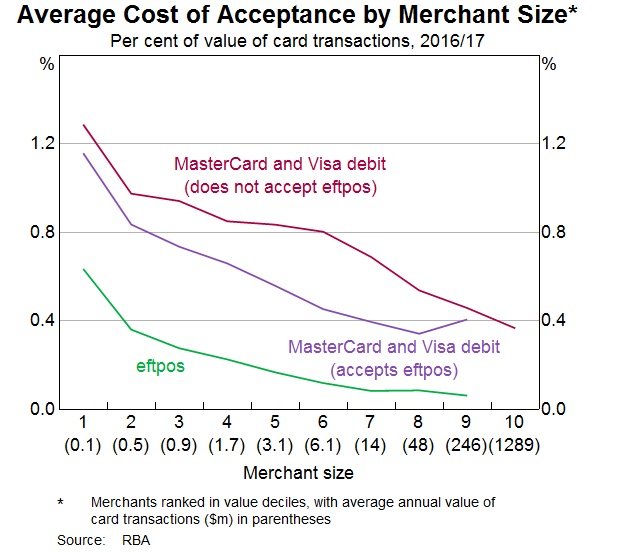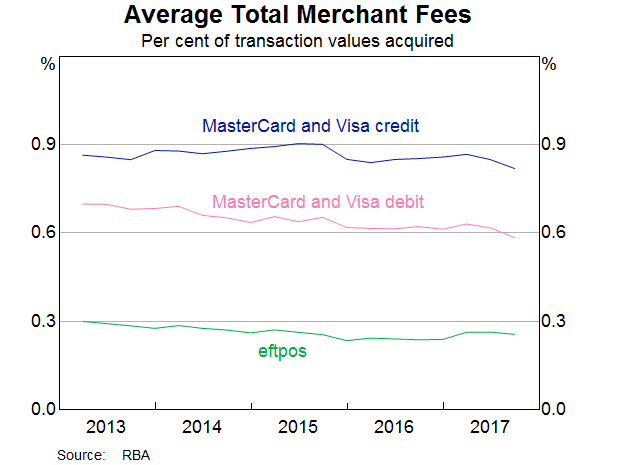Speech Merchant Payment Costs and Least-cost Routing

Tony Richards[*]
Head of Payments Policy
Australian Payment Summit 2017
Sydney –
- Audio 12.5MB
- Q&A Transcript
- Download 291KB
There is a lot of talk about the shift that is occurring from older payment methods such as cash and cheques towards electronic methods such as cards, BPAY, and other electronic funds transfers like the ‘pay anyone’ functionality offered in online banking. For example, in the recent consultations around the Black Economy Task Force, merchants and merchant organisations expressed interest in switching away from cash to electronic payments. And the Reserve Bank's support for the New Payments Platform over the past five years has very much reflected our desire to improve the quality of electronic payment services that are available to consumers, businesses and government entities.
However, merchants have also expressed concerns that electronic payments can be quite expensive. More specifically, many have indicated that the cost of payments has increased as debit card transactions are shifting from PIN to contactless (or tap-and-go) authorisation.
Today I am going to summarise some new data on the cost of payments to merchants and discuss least-cost routing, which is a current policy issue in this area.
Some Data on Merchant Payment Costs
The Reserve Bank recently asked all the larger acquirers to provide anonymised merchant-level data on the costs to merchants of accepting different types of cards. We asked them for data for 2016/17 on the total value of card payments and average cost of payments (in terms of merchant service fees and other costs) for all the four-party card payment systems (eftpos, Debit MasterCard, Visa Debit, MasterCard credit, Visa credit, and UnionPay). These data correspond to the information that acquirers were required to provide merchants as part of the new surcharging framework.[1]
After a small amount of trimming of outliers, we have data for around 680 000 merchant accounts. My first graph shows a scatter plot of the average total cost of card payments (across all schemes) for those merchants. It is apparent that there is a wide range in the cost of payments for merchants of different sizes. But the darker parts of the graph hint at a tendency for merchants' payment costs to fall as their transaction values rise.

My next graph divides merchants into ten different groups ranked by the value of annual transactions, with each group accounting for 10 per cent of the value of all card transactions. The first group includes the smallest merchants (around 490 000 merchants with average annual transactions of $92 000) and the tenth group includes the largest (35 merchants with average transactions of $1.3 billion). The graph shows the average cost for different payment schemes, but with MasterCard and Visa grouped together.

The data clearly show the tendency for larger merchants to have lower payment costs and they also show debit cards to be cheaper than credit cards. For merchants of all sizes, eftpos is a lower-cost system on average than the debit systems of MasterCard and Visa. And the credit systems of MasterCard and Visa are less expensive on average than UnionPay (UnionPay transactions in Australia are nearly all on cards issued overseas).
Why do smaller merchants tend to have higher average payment costs? There are several reasons:
- There are some fixed costs associated with providing payment services to merchants, and smaller merchants have a lower volume of transactions to spread these over.
- Smaller merchants may have less bargaining power with acquirers.
- Smaller merchants are less likely to benefit from strategic or preferred interchange rates from card schemes.
- Smaller merchants may be less financially sophisticated and may not always choose, or be offered, plans from their acquirers that would minimise their payment costs. For example, banks' websites are increasingly highlighting plans whereby the merchant pays a fixed dollar amount each month for card transactions up to a certain total value, and then a fixed percentage amount, typically around 1.5 per cent, for all transactions above that amount. While these plans may be convenient for some merchants, a key point is that there is no differentiation in the price of different schemes to merchants selecting them. For example, merchants are paying the same rate for an eftpos transaction as they are for other schemes, even though eftpos transactions will normally cost the acquirer much less to provide.
I will now focus on the data for the cost of debit card transactions.
The simple averages of payment costs for eftpos and the international debit schemes across all 680 000 merchant accounts suggest a cost differential of 37 basis points. However, this may not be a good estimate of the average difference in payment costs for any merchant because of differences in the size of merchants across the schemes and differences in their transaction mixes.
The average gap between the two bottom lines in the previous graph can be viewed as a measure of the difference in average costs between eftpos and the international schemes which controls for differences in merchant size across schemes. This gap suggests that debit transactions via the international schemes typically cost merchants about 44 basis points more than transactions via the domestic eftpos system in 2016/17.
One additional factor to control for is compositional differences in transaction types. For example, eftpos transactions are all point-of-sale transactions whereas the international schemes also facilitate card-not-present transactions. One way to control for this difference is to divide merchant accounts into those that accepted both eftpos and the international schemes, and those which accepted the international schemes but not eftpos. The former group are likely to be bricks-and-mortar or point-of-sale merchants, whereas the latter are likely to be billers or online merchants. [2]
My next graph shows the results of that exercise. It shows that there remained a large difference in the cost of debit transactions for those merchants which accept both eftpos and the international schemes, with an average gap of 39 basis points in 2016/17.

Now there may be other differences in the nature of the transactions of the different debit schemes. For example, eftpos transactions are all on domestically issued cards, whereas some MasterCard and Visa transactions will be on international cards. We have done some figuring which suggests that this may explain part of the difference in the above graph, possibly around a quarter of it. But the overall message appears to be that eftpos is generally a less expensive payment method for merchants, even after controlling for differences in merchant size, for an important difference in merchant type, and for the mix of domestic and foreign transactions. This should not be surprising given that scheme fees and interchange fees have both tended to be lower for eftpos than for the international debit systems.
While eftpos is a lower-cost scheme on average across all merchant sizes, we can use the merchant-level data to see if there is some proportion of merchants for whom this is not the case. For example, given that eftpos is often priced to merchants on a cents-per-transaction basis, while international scheme debit is usually charged on a percentage basis, merchants with low average transaction sizes may see little difference in their payment costs. In some circumstances, for example coffee shops and other merchants where the ticket size is typically very low, merchants may face higher acceptance costs for eftpos.
Looking at those merchants which accept both eftpos and international scheme debit, the data indicate that international scheme debit is less expensive for merchants accounting for around 4 per cent of the value of debit card transactions, and that there is little difference in cost between the schemes for merchants accounting for around 8½ per cent of transactions. However, eftpos is less expensive for the large majority of merchants – representing around 87½ per cent of the value of debit card transactions.
The data I have just talked about are for the 2016/17 financial year. So they predate the reset of interchange rates for the international schemes that occurred on 1 July.
We do not have merchant-by-merchant payment costs for the period after the interchange reset, but we do have some aggregate data from our regular Retail Payments Statistics collection. These data show that there was a fall of 3 basis points in average merchant fees for debit transactions in the MasterCard and Visa systems in the September quarter. So there has been some modest narrowing in the gap between scheme debit and eftpos. However, the data continue to show a significant difference in average payment costs, of around 32 basis points.[3] In addition, when expressed in cents rather than basis points, the reduction in average merchant costs in the September quarter was less than half of the reduction in actual interchange payments in the quarter. Hence it is apparent that acquirers are yet to pass through the majority of the reduction in their interchange costs.

Least-cost Routing
Given that payment costs are a significant item for merchants, it is not surprising that merchants pay attention to them. Just as merchants are keen to hold down other business costs, they are also keen to hold down their payment costs. Recently, they have drawn attention to a particular issue that is driving up their cost of payments.
The majority of debit cards issued in Australia are now dual-network cards, which means that authorisation of cardholders' debit transactions can occur through different networks – the domestic eftpos network or the debit networks of the international MasterCard or Visa schemes. If you look at your debit or ATM card, there is a good chance it will have an international scheme logo on one side and the eftpos logo on the other.
Traditionally, cardholders have determined how their debit transactions are processed, by pressing either the CHQ or SAV buttons for eftpos or the CR button for the international network, before entering their PIN. However, with the shift to contactless or ‘tap-and-go’ transactions, the processing of debit transactions has been shifting to the international networks. This initially reflected the fact that contactless payments were only available for the international schemes. Most cards and terminals are now also activated for eftpos contactless functionality. However, when card-issuing banks send out dual-network debit cards they are programmed with the international scheme as the first-priority network for contactless use and the eftpos network as second priority.
Most cardholders are indifferent about which network processes their contactless transactions. Both networks can link to the same debit account and cardholders do not directly bear the costs of the transactions. Moreover, there are typically no rewards programs associated with debit transactions, and customers receive similar protections from fraud and disputed transactions, based on the ePayments Code and the chargeback policies of the three schemes.
However, many merchants have a preference for transactions to be processed via the eftpos network, because – as I have illustrated – it is typically less expensive for them. Accordingly, many merchants have been calling for their acquirer banks to provide them with ‘least-cost routing’, i.e., terminal functionality that sends contactless debit transactions via the lower-cost network. Terminals might be programmed to always send dual-network card transactions via a particular network or they might use dynamic rules which identify the lower-cost network for each transaction.[4]
The Bank has had discussions with consumer organisations and staff from the Australian Competition and Consumer Commission (ACCC) as to how least-cost routing might be implemented. We consider that it would be desirable for a merchant implementing least-cost routing to disclose this to customers. Depending on how terminals were actually programmed, this could be by a sign that the merchant will typically send tap-and-go debit card transactions via a certain network, but noting that customers wishing to send transactions via a different network could insert or dip their cards and push the button or keypad for their preferred network. A sign such as this would provide consumers with the opportunity to override the merchant's preferred network if they wished. Such a framework would seem to be a reasonable balance between the rights of merchants and consumers, and it is likely that consumers would quickly become used to the idea that their transactions could be sent via different networks at different merchants.
The Reserve Bank has taken an interest in dual-network card issues because of the Payments System Board's mandate to promote competition and efficiency. As the Bank and other observers of the payments system have frequently noted, the nature of competition in the payment card market is often such that it tends to drive up costs to merchants, as schemes increase their interchange fees to persuade issuers to issue their cards.[5] Merchants have typically had little ability to offset these pressures (in the absence of regulatory intervention to cap interchange fees or remove schemes' no-surcharge rules). However, dual-network cards can potentially offset the pressures for payment costs to rise, because the merchant may be able to steer the consumer to use the lower-cost of the two networks on a card. Accordingly, the Bank has indicated that it supports the issue of such cards in Australia, because they are convenient for cardholders and allow stronger competition between networks at the point of sale, facilitating both consumer and merchant choice.
Some disputes over dual-network debit cards emerged between the debit schemes in 2012-13. However, after a series of discussions with the Bank, in August 2013 the three debit schemes made voluntary undertakings to the Bank that addressed some policy concerns. These included commitments:
- to work constructively to allow issuers to include applications from two networks on the same card and chip, where issuers wished to do this;
- not to prevent merchants from exercising choice in the networks they accept, in both the contact and contactless environments; and
- not to prevent merchants from exercising their own transaction routing priorities when there are two contactless debit applications on one card.
As noted above, most terminals and eftpos cards are now enabled for tap-and-go eftpos transactions. Given the Bank's views about the potential competition and efficiency benefits of dual-network cards, as well as the earlier commitments by the three debit schemes, the Bank has been liaising with a range of stakeholders over recent months to encourage the provision of least-cost routing functionality to merchants.
However, until very recently, acquirers have indicated reluctance to provide least-cost routing to their merchant customers. This is partly due to the expected systems work, including to reprogram terminals.
In addition, some merchants have expressed concern to the Bank that the international schemes might resist the implementation of least-cost routing. To the extent that transactions via the international schemes are currently more expensive to merchants, a possible outcome of least-cost routing becoming available would be for the international schemes to reduce scheme or interchange fees so that merchants have little incentive to send transactions via another network. However, some merchants are concerned about other possible responses, including that the international schemes might respond to a merchant's decision to implement least-cost routing of debit transactions by increasing the interchange rates that apply to the merchant's credit transactions. They have also noted that the international schemes might try to preclude least-cost routing by attempting to persuade issuers to stop issuing dual-network cards. The ACCC is aware of these concerns, and is closely monitoring the situation. With the passage of the Harper reforms, which came into effect in November this year, the ACCC now has even stronger powers to investigate and take action in relation to conduct by the international schemes that might hinder competitive conduct by a lower-cost provider.
The Payments System Board has discussed issues involving dual-network cards in recent meetings. At its 17 November meeting, the Board strongly supported calls from a range of stakeholders for acquirers to provide merchants with least-cost routing functionality for contactless transactions using dual-network debit cards. It requested the Bank staff to continue to engage with the payments industry on this issue, noting that ‘a prompt industry solution was preferable to regulation’.
More recently, the Review of the Four Major Banks by the House of Representatives Standing Committee on Economics has made the following recommendation:
“The committee recommends that banks be required to give merchants the ability to send tap-and-go payments from dual-network debit cards through the channel of their choice.
Merchants should be able to choose whether to route these transactions through eftpos or another channel, noting that consumers may override this merchant preference if they choose to do so.
If the banks have not facilitated this recommendation by 1 April 2018, the Payments System Board should take regulatory action to require this to occur.”
Recent indications are that all four of the major banks are moving to providing least-cost routing if requested by merchants, though in some cases they have indicated this could occur on a fairly extended timetable. We expect that some of the smaller acquirers may be able to move more quickly.
Accordingly, the Bank expects that by early in 2018 there will be concrete indications that a critical mass of acquirers are moving to provide least-cost routing and that the international schemes are not attempting to prevent this. However, if this expectation is not met, I expect that the Payments System Board will consider consulting on a regulatory solution that deals with all the relevant considerations. While of course the measures that could be consulted on will be determined by the Board, I can imagine that this could involve considering whether some or all of the following measures might be in the public interest:
- a requirement that acquirers must provide merchants with least-cost routing functionality for contactless dual-network debit card transactions
- a requirement for enhanced transparency in contractual pricing of acquiring services to merchants
- requirements that schemes publish explicit criteria for any preferred or strategic interchange fees and that any such criteria may not be related to acceptance decisions relating to other payment systems
- anti-avoidance provisions that ensure adherence to the spirit, as well as the letter, of any standard.
Conclusion
As the economy shifts away from paper-based payments, it is important that the payments system provides end users with access to low-cost electronic payments. Debit cards, which are one of the basic payment instruments in any payments system, are likely to be an important element of this. Indeed, based on the most recent data, it is likely debit cards will soon overtake, or may have already overtaken cash as the most frequently used method of payment in the Australian economy.
Given the ubiquity of debit cards and their importance for consumers and merchants, the Bank will continue to pursue its mandate of promoting competition and efficiency in this segment of the payments system. Many of you are participants in this market, and we look forward to you providing this competition.
Endnotes
Thanks to Cameron Dark and Ed Tellez for their contribution to this talk. [*]
This data request was unrelated to the usual data provided for the Bank's Retail Payments Statistics, which are published in the Bank's Statistical Tables. However, data from the two sources are consistent in terms of average costs across the different systems. [1]
The fact that there are no observations for eftpos for the tenth decile suggests that the 35 merchant accounts in this group are online merchants or billers; as such they might have a single merchant account, whereas a bricks-and-mortar chain with a similar annual transaction value (and which accepts eftpos) would be likely to have separate merchant accounts for each location. [2]
As demonstrated above, the average cost differential for all merchants will be affected by differences in the average size of merchant accounts between eftpos and the international schemes. As a result, this average cost differential may understate the typical cost differential for any particular merchant of a given size. [3]
It should be stressed that the discussion about least-cost routing relates only to cards with two debit networks enabled and linking to the same debit account. It would not apply to ‘combo’ cards which have both debit and credit functionality—for these cards the cardholder will have strong preferences as to how a transaction is processed, because it involves different accounts. [4]
See, for example, the Reserve Bank's Submission to the Financial System Inquiry, March 2014, p 206. [5]